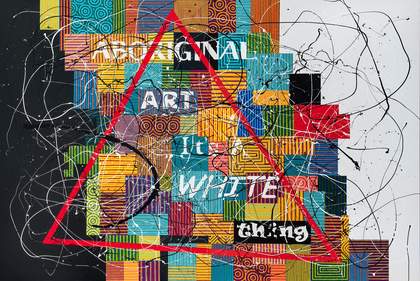Richard Bell lives and works in Brisbane. He is a descendent of the Kamilaroi, Kooma, Jiman and Goreng Goreng peoples. He was an activist and community worker for the New South Wales Aboriginal Legal Service in the 1980s before becoming a full-time artist and co-founding the Aboriginal art collectives Campfire Group in 1990 and proppaNow in 2004. He works across painting, installation, performance, and video. Bell is one of Australia’s most significance artists and his work explores the complex artistic and political problems of Western, colonial and Indigenous art production. He grew out of a generation of Aboriginal activists and has remained committed to the politics of Aboriginal emancipation and self-determination.
Iswanto Hartono is an artist, architect and curator who lives and works between Jakarta and Kassel. Hartono is one of the few contemporary Indonesian artists with a background in architecture. Known as an artist with a conceptual base, Hartono has been exhibiting his works since the late nineties, showing works with a strong social and political content. Hartono’s works betray his interest in his- tory/memory, globalization, and geopolitical powers, post-colonial, in race/identity. Most of his works deliberately steer away from explosive and responsive artistic expressions and presenting unpredictable idioms. Hartono is particularly interested in parts of that country’s history that have consciously been forgotten. His previous projects revolved around colonisation and post-colonial debates and the battle of identity in contemporary Indonesia. Some of his latest exhibitions: Beyond Wonder: Perspective of Utopia, Tokyo Wonder Site, Nagoya (2018), DAK’ART 2018, during Dakar Biennale 2018 [Para-Site]; and his latest self-titled solo show, staged in Oudekerk, Amsterdam, during Europalia Indonesia (2017).With his partner-in-crime, also in ruangrupa’s ArtLab, Reza Afisina, he established a conceptual duo: RAIH.
Pembroke House is a centre for social action and residential community embedded in the neighbourhood of Walworth. It aims to build and strengthen social connections through mutual support and care across a range of programmes including the Pembroke Academy of Music, Inclusive Dance, Walworth Living Room (Cafe, Community Fridge), We Walworth, and the Walworth Neighbourhood Food Model
The Otolith Group was founded in 2002 by Anjalika Sagar and Kodwo Eshun who live and work in London. During their longstanding collaboration, Sagar and Eshun have drawn from a wide range of resources and materials. Their collective practice is research-based and informed by essayistic moving images, audio, performance, installation and curation. Characterized by an engagement with cosmogonic aesthetics they evoke the interscalar imagination of differentiated planetarity exploring science fictions of the present that entails the work of temporal anomalisation, anthropic inversion and synthetic alienation. The Otolith Group has exhibited internationally and was nominated for the Turner Prize in 2010. Recent solo exhibitions include What the Owl Knows Secession, Vienna (2022-2023); Xenogenesis, Irish Museum of Modern Art, Dublin (2022-2023), Sharjah Art Foundation (2021-22), Southern Alberta Art Gallery, Lethbridge (2020), Buxton Art Gallery, Melbourne (2020), Institute for Contemporary Art at Virginia Commonwealth University, Richmond (2020), and Van Abbe Museum, Eindhoven (2019).
Shaheen Merali (born in Tanzania, lives in Britain) is a curator, critic, and artist of Indian heritage. Merali began his artistic practice in the 1980s, committing to social, political, and personal narratives. As his practice evolved, he focused more on his work as a curator, and has now moved into the sphere of research and writing. He is currently a PhD candidate at Coventry University, based at the Centre for Arts, Memory and Communities, Research Institute for Creative Cultures. His research is concerned with contemporary political Black
arts practices that emerged in the Asian-African diaspora culture in the early 80s and their relationship to the curatorial and self -organisational formations in British arts. Merali was the curator for the inaugural Uganda Pavilion, Radiance – They Dream in Time, for the International art exhibition for the 59th Venice Biennale. At the Golden Lion Ceremony, the pavilion was presented the special mention award. He was the co-curator of Berlin Heist or
the enduring fascination of walled cities for the 4th Mediations Biennale, Posnan, Poland (2014) and co-curator of the 6th Gwangju Biennale, Korea (2006). Merali was the Head of Department of Exhibition, Film and New Media at the Haus der Kulturen der Welt, Berlin (2003-2008) where he curated several exhibitions accompanied by publications, including The Black Atlantic; Dreams and Trauma- Moving images and the Promised Lands; and Re-Imagining Asia, One Thousand years of Separation. In 1988, Merali had co-founded the Panchayat Arts Education Resource Unit in East London. The Unit's main function was one of collecting ephemera, documents, and publications, detailing the work of political British Black artists (of Asian and African descent). In 2015 the Panchayat archival material was donated and is part of the Tate Library's Special Collection in London.
Alexander Supartono is an art historian and curator specialising in modern and contemporary art in Southeast Asia and lecturer at the School of Arts and Creative Industries, Edinburgh Napier University. He obtained a PhD in History of Photography from the University of St. Andrews, Scotland. Recent curatorial activities include Postcolonial Photo Studio 4 (Chobi Mela Festival, Dhaka, 2017) and Flame of Solidarity, the presentation of Taring Padi collective at the documenta fifteen (Kassel, Germany, 2022). Latest publications include co-edited book Dolorosa Sinaga: Body, Form, Matter (2020) and article The Silent Waiting: Javanese Antiquity and 19th Century Photography in the Dutch East Indies (2022). Presently he is one of principal investigators at the Getty Research Institute’s Photography Unbound project that explores computational methods to analyse large collections of digital images and the application computer vision to art historical questions.
Franca Tamisari teaches Cultural Anthropology and is the Head of the Anthropology Program at Ca’ Foscari University of Venice. She has also lectured at the University of Sydney and the University of Queensland (1996-2004).

